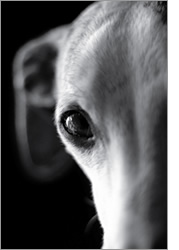The 2008 G. Burroughs Mider Lecture
The Long and Short of It: Genes that Control Body Size in the Domestic Dog
 Over several hundred years, closed breeding has produced a fantastic variety in the size and shape of more than 400 recognized dog breeds. For the October 22, 2008 G. Burroughs Mider Lecture, Elaine Ostrander, Ph.D., chief of NHGRI's Cancer Genetics Branch, described how gene mapping and population genetics have led to recent discoveries about dog morphology. Dr. Ostrander's lab studies human and canine genetics, focusing on the genetics of complex traits like cancer, autoimmune disease and morphology.
Over several hundred years, closed breeding has produced a fantastic variety in the size and shape of more than 400 recognized dog breeds. For the October 22, 2008 G. Burroughs Mider Lecture, Elaine Ostrander, Ph.D., chief of NHGRI's Cancer Genetics Branch, described how gene mapping and population genetics have led to recent discoveries about dog morphology. Dr. Ostrander's lab studies human and canine genetics, focusing on the genetics of complex traits like cancer, autoimmune disease and morphology.
The G. Burroughs Mider Lecture recognizes a National Institutes of Health, intramural scientist's outstanding contributions to biomedical research, and honors G. Burroughs Mider, the first NIH director of laboratories and clinics.
From Lecturer Dr. Elaine Ostrander
 In the last few centuries subpopulations of dogs have developed into closed populations as a result of differential selection for traits associated with both behavior and appearance.
This practice, coupled with small numbers of founders for many breeds has generated a population that is ideal for mapping genes underlying morphology, behavior, and disease susceptibility. In today's lecture we will summarize advances regarding the canine genome project and current approaches for finding genes controlling both simple and complex traits. In particular, we will discuss genes controlling body size, fur texture, and leg length, and the implications of these findings for advancing our knowledge regarding disease gene mapping.
In the last few centuries subpopulations of dogs have developed into closed populations as a result of differential selection for traits associated with both behavior and appearance.
This practice, coupled with small numbers of founders for many breeds has generated a population that is ideal for mapping genes underlying morphology, behavior, and disease susceptibility. In today's lecture we will summarize advances regarding the canine genome project and current approaches for finding genes controlling both simple and complex traits. In particular, we will discuss genes controlling body size, fur texture, and leg length, and the implications of these findings for advancing our knowledge regarding disease gene mapping.
Last Reviewed: December 13, 2011






